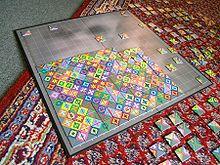An edge-matching puzzle is a type of tiling puzzle involving tiling an area with (typically regular) polygons whose edges are distinguished with colours or patterns, in such a way that the edges of adjacent tiles match.
Edge-matching puzzles are known to be NP-complete, and capable of conversion to and from equivalent jigsaw puzzles and polyomino packing puzzle.[1]
The first edge-matching puzzles were patented in the U.S. by E. L. Thurston in 1892.[2] Percy Alexander MacMahon published a treatise on edge-colouring of a variety of shapes in 1921.[3]
Current examples of commercial edge-matching puzzles include the Eternity II puzzle, TetraVex, Dodek Duo, Kadon Enterprises' range of edge-matching puzzles, and the Edge Match Puzzles iPhone app.
The Carcassonne board game employs edge matching to constrain where its square tiles may be placed. The original game has three types of edges: fields, roads and cities.
See also
- Domino tiling
- Serpentiles
- Three-dimensional edge-matching puzzle
- Wang tiles
References
- ^ Erik D. Demaine, Martin L. Demaine. "Jigsaw Puzzles, Edge Matching, and Polyomino Packing: Connections and Complexity" (PDF). Retrieved 2007-08-12.
- ^ "Rob's puzzle page: Edge Matching". Archived from the original on 2007-10-22. Retrieved 2007-08-12.
- ^ MacMahon, Percy Alexander (1921). New mathematical pastimes. Gerstein - University of Toronto. Cambridge, University Press.
External links
- Erich's Matching Puzzles Collection
- Color- and Edge-Matching Polygons by Peter Esser
- Rob's puzzle page by Rob Stegmann
- Edge matching squares

